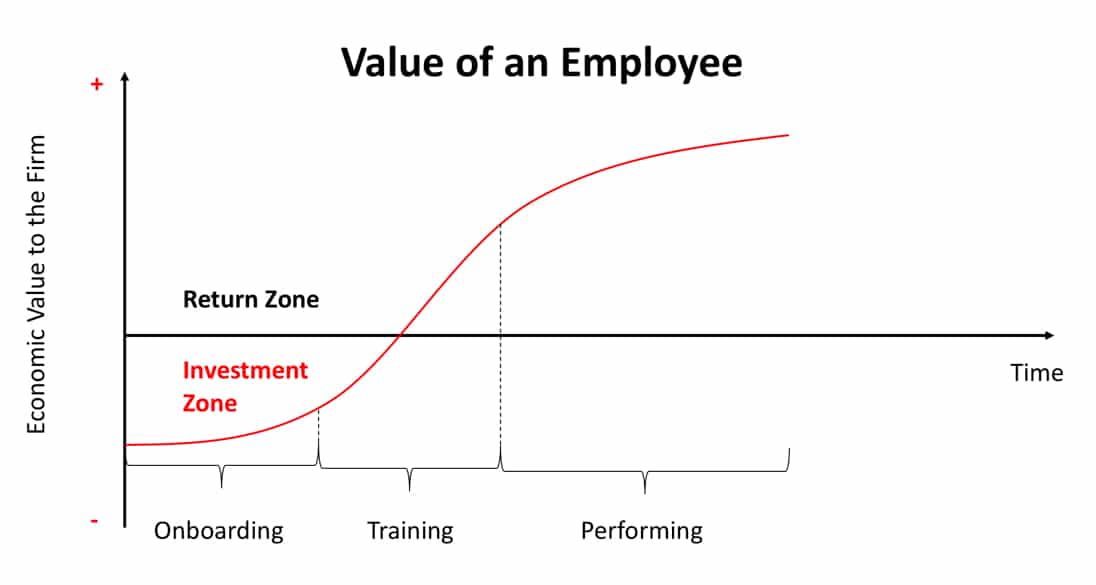In my last blog post we looked at six reasons employee’s leave an organisation. Voluntary turnover is the most crucial type for firms to focus on as it can be impacted by management decisions and organisational styles. We also looked at some of the reasons that motivate people to voluntarily leave an organisation. You can find the detailed post here.
In this instalment, we will look at:
- Costs of high employee turnover
- Employee turnover segmented by country
1. Costs of High Employee Turnover
According to Josh Bersin from Deloitte, when a new hire begins at a firm, there is a distinct period (30-90 days) called the “Investment Zone” where the firm invests in training and the new employee is learning rather than adding value to the organization. This phase is the best time for an employee to leave the firm because, although the organization hasn’t achieved a return on its investment, they have saved time. They didn’t invest too much time in the employee and since the employee hasn’t yet become a valued contributor to the firm, the opportunity cost of their departure is still relatively low. This helps to explain the rationale behind the 3-month probation period that most firms give to an incoming employee.
As time spent at an organization increases, so should the level of employee engagement and thus the effort to retain the employee and the cost of replacing the employee also increase. Retention efforts are especially important after the two-year mark because it can take up to two years for a new employee to reach a similar level of productivity as an existing staff member. It is interesting to note that most management consultants exit into industry after 1 or 2 years, meaning that consulting firms are losing the period during which their consultants would be of most value to them. This “2 year” number may explain the rationale behind the now common and sought after ‘management trainee’ or ‘rotational programs’ that many organizations offer newly graduated business students. These prestigious programs engage talented young people (and in a way, imitate consultant work) by allowing them to work on different teams, in different departments and sometimes even in different countries over the course of two years. After this, high performing talent is incentivized to stay by being offered a management level position or a department of their choice.
After a period, an employee will normally enter the “Return Zone.” This indicates that the employee has gotten up to speed with tasks, built working relationships with teammates, and has become a productive contributor. The employee is now providing value to the organization.
Costs associated with employee turnover in the Return Zone are likely to be much higher, and may include:
- Redundancy payments – if the employee is asked to leave then they may be entitled to a lump sum payment proportional to their salary and the length of time they worked for the firm
- Lost revenue – revenues may be lost if client work needs to be delayed or put on hold. Revenues may also be lost if the departing employee had strong client relationships and takes clients with them
- Recruitment costs – it takes time and effort to recruit new employees, and this can be especially costly if the required employees are experienced and the services of a headhunter are required
- Training costs –new employee need to pass through a period of onboarding and training during which they have a negative economic value to the firm
Fitz–Enz (2009), who coined the term ‘ROI of Human Capital’, also included costs such as:
- Reduced productivity – the learning curve effect posits that average production costs fall in a predictable manner with total accumulated production. Empirical research has consistently shown this to be the case such as in the aircraft industry (T.P. Wright 1936) and semiconductor manufacturing (BCG 1966). Employees who leave take their accumulated experience with them, which can lead to reduced productivity.
- Loss of morale – People form social relationships at work and when an employee leaves, some of these bonds are broken. This can lead to reduced morale and result in reduced productivity for remaining team members. The reason for employee departure can affect the impact on morale. For example, if many well-liked yet perhaps low performing employees are fired during normal economic conditions to ‘reduce costs,’ this could have a very negative impact on morale, productivity, and employee turnover.
According to Fitz-Enz, costs associated with termination, replacement, vacancy, and productivity losses following the loss of a professional or manager can cost a firm one year’s worth of pay and benefits at a minimum. Furthermore, the reduced morale of the team can last for years after the employee leaves. The firm may have to invest additional resources to return the team to its original baseline level of productivity.
2. Employee Turnover Segmented by Country
Some countries experience higher employee turnover than others. It is interesting to look at countries with different levels of employee turnover and ask the question, “why?” This can help firms understand the best HR practices and orchestrate a stronger employee strategy. Randstad, a HR consulting firm, conducted extensive research in 2015 in which they surveyed over 220,000 employees across 22 countries. So, let’s take a look at some of their survey results:
A. Did you or would you change employers in the past 12 months?
- Lowest turnover: Japan, Netherlands, Belgium
- Lowest potential turnover: Belgium, Japan, Germany
- Highest turnover: Russia, Hungary, India
- Highest potential turnover: India, China, Singapore
B. What factors contributed to your decision to leave your employer?
The three biggest drivers of turnover globally:
- Lack of career prospects
- Salary too low
- Poor work–life balance
C. What proportion of employees choose to stay with their current employer?
- People stay the most in Japan, Luxembourg, Belgium, Germany
- People stay the least in India, Singapore, China
D. What factors make you stay with your current employer?
The three biggest drivers of employee commitment globally:
- Good work – life balance
- A tie between flexible work options and competitive salaries
- Recognition for work
If we look at question A and C above, we find that firms in some countries consistently do better at retaining employees. We hear about companies that have put in the time and effort to study their people and provide them with the best opportunities to thrive. It comes as no surprise when many of them are recognized on lists such as “The 100 best companies to work for.” Perhaps there should also be a “10 best countries to work in” list based on their culture of people management. I’m not saying that we should all move to Japan, Netherlands, Belgium or Germany, but we should perhaps look more closely at the People Management Practices that firms in these countries are using.
If we look at question D above, we notice that the top three reasons that people stay at a firm are all relationship-based. Yes, salary is important but it is consistently not the most important factor for why people choose to stay. People seem to stay at organizations that care about them.
- Care enough to give work life balance. At some point people will have their personal lives to take care of. There are numerous studies which indicate that if employees are happy in their personal lives they will be happier and more productive at work. Oswald et al (2015) claims that happiness leads to a 12% increase in productivity.
- Care enough to give flexible work options. Requiring employees to time stamp their way into and out of the office at the same time every day is likely to be seen by employees as micromanagement. Firms who are more successful at retaining employees trust that they hired competent people who will deliver results, but that they can do this in a way they find to be most efficient.
- Care enough to recognize employee achievements, offering gratitude and celebrating successes.
Employee turnover has been and is still a big managerial problem, however large problems hold the potential for innovative solutions.
To sum up, this post introduced two critical periods that an employee goes through when joining a firm, highlighted the staggering costs of employee turnover, and underlined the top reasons why employees choose to stay at their workplace across different countries.
Stay tuned for the next instalment where I will discuss the trends surrounding innovative work spaces.
Aneta Kosinska is a Polish-Canadian and soon to be dual master degree Ivey MSc + CEMS MIM alumni. Having worked on consulting projects in North America, Asia and Europe she has developed an international mindset with an edge in technology and culture management.
Image: Pexels

